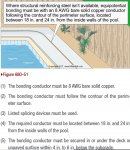Hello All,
Just FYI, we purchased our home last summer and some of the metal parts around our pool had lost their bond (one leg of ladder, diving board). I can only assume the original copper bonding wire (15-20yrs old) broke under the slab. Anyhow, I ran new #8 copper wire and re-bonded all the metal parts of the pool (step railing, ladder, diving board) in addition to all the equipment (pump, swg, etc). I also bonded it with the original copper wire.
Now, I have a question about equipotential bonding in regards to our concrete decking and coping.
1. My original plan was to encircle the entire outside of the swimming pool deck with a single #8 copper wire, which I am utilizing. I was then going to run individual pieces of #8 copper wire down each concrete slab divider and attach it to the pools aluminum coping via stainless screws and nuts. This would at least give me some perimeter bonding within the interior of the pool and areas within the concrete decking. That was the goal because there is no rebar in the concrete for bonding purposes. They only bonded the metal parts and equipment which is probably all that was required 20 yrs ago. I still plan on doing this unless you tell me otherwise.
2. I recently cut several 1ft x 1ft holes into the concrete to add lights and some water features. Anyhow, the earth underneath the concrete decking has settled about 4-5 inches. So I have an opportunity to run a single #8 copper wire around the interior of the pool or 18 to 24in within the pool side which I believe is the recommended bonding method? I could also run some concrete wire mesh but it would only be about 14in wide. I wouldn't be able to reach every point around my pool with the wire mesh but I probably could get about 80%. I think I can get about 95% with the single #8 copper wire.
After I have ran my copper wire and/or mesh, I plan on filling the voids under my decking with a mortar/sand mix to help support the deck. I will use concrete to fill the holes themselves.
Can you offer any suggestions in regards? Will the #8 copper or mesh be fine in the sand under my concrete deck or does it need to be encased within concrete?
Thanks,
Ralph
Just FYI, we purchased our home last summer and some of the metal parts around our pool had lost their bond (one leg of ladder, diving board). I can only assume the original copper bonding wire (15-20yrs old) broke under the slab. Anyhow, I ran new #8 copper wire and re-bonded all the metal parts of the pool (step railing, ladder, diving board) in addition to all the equipment (pump, swg, etc). I also bonded it with the original copper wire.
Now, I have a question about equipotential bonding in regards to our concrete decking and coping.
1. My original plan was to encircle the entire outside of the swimming pool deck with a single #8 copper wire, which I am utilizing. I was then going to run individual pieces of #8 copper wire down each concrete slab divider and attach it to the pools aluminum coping via stainless screws and nuts. This would at least give me some perimeter bonding within the interior of the pool and areas within the concrete decking. That was the goal because there is no rebar in the concrete for bonding purposes. They only bonded the metal parts and equipment which is probably all that was required 20 yrs ago. I still plan on doing this unless you tell me otherwise.
2. I recently cut several 1ft x 1ft holes into the concrete to add lights and some water features. Anyhow, the earth underneath the concrete decking has settled about 4-5 inches. So I have an opportunity to run a single #8 copper wire around the interior of the pool or 18 to 24in within the pool side which I believe is the recommended bonding method? I could also run some concrete wire mesh but it would only be about 14in wide. I wouldn't be able to reach every point around my pool with the wire mesh but I probably could get about 80%. I think I can get about 95% with the single #8 copper wire.
After I have ran my copper wire and/or mesh, I plan on filling the voids under my decking with a mortar/sand mix to help support the deck. I will use concrete to fill the holes themselves.
Can you offer any suggestions in regards? Will the #8 copper or mesh be fine in the sand under my concrete deck or does it need to be encased within concrete?
Thanks,
Ralph


